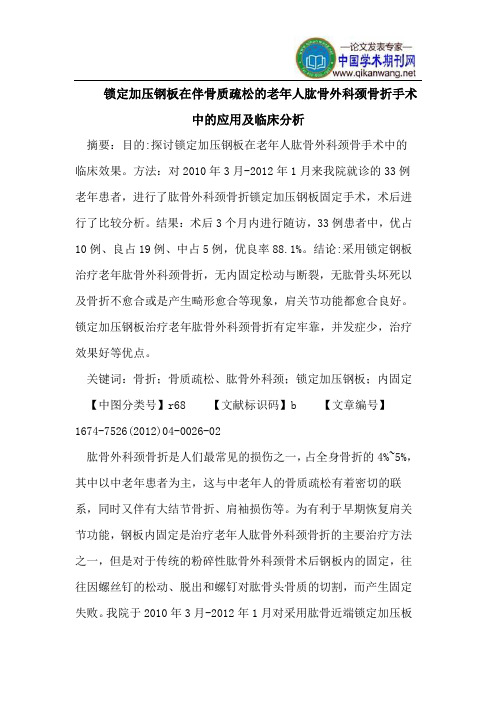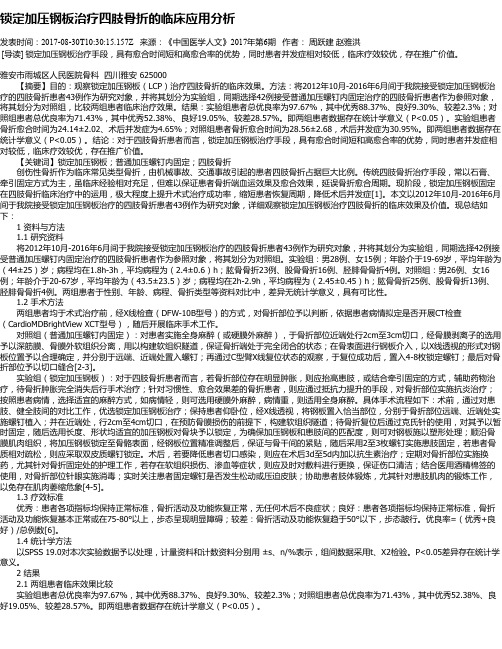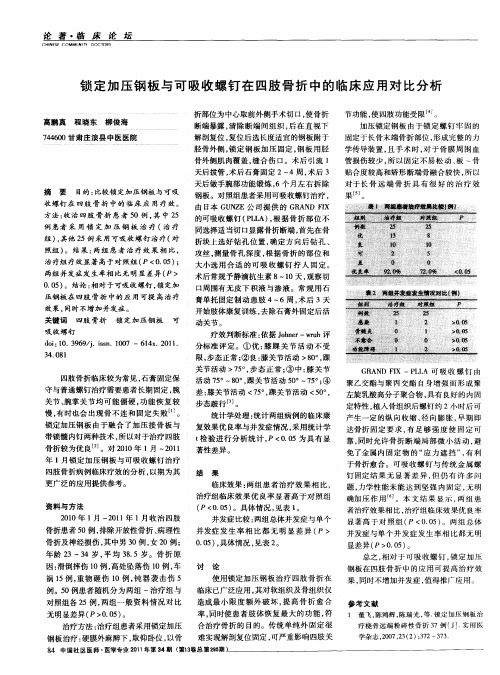锁定加压钢板原理及临床应用
锁定加压钢板在伴骨质疏松的老年人肱骨外科颈骨折手术中的应用及临床分析

锁定加压钢板在伴骨质疏松的老年人肱骨外科颈骨折手术中的应用及临床分析摘要:目的:探讨锁定加压钢板在老年人肱骨外科颈骨手术中的临床效果。
方法:对2010年3月-2012年1月来我院就诊的33例老年患者,进行了肱骨外科颈骨折锁定加压钢板固定手术,术后进行了比较分析。
结果:术后3个月内进行随访,33例患者中,优占10例、良占19例、中占5例,优良率88.1%。
结论:采用锁定钢板治疗老年肱骨外科颈骨折,无内固定松动与断裂,无肱骨头坏死以及骨折不愈合或是产生畸形愈合等现象,肩关节功能都愈合良好。
锁定加压钢板治疗老年肱骨外科颈骨折有定牢靠,并发症少,治疗效果好等优点。
关键词:骨折;骨质疏松、肱骨外科颈;锁定加压钢板;内固定【中图分类号】r68 【文献标识码】b 【文章编号】1674-7526(2012)04-0026-02肱骨外科颈骨折是人们最常见的损伤之一,占全身骨折的4%~5%,其中以中老年患者为主,这与中老年人的骨质疏松有着密切的联系,同时又伴有大结节骨折、肩袖损伤等。
为有利于早期恢复肩关节功能,钢板内固定是治疗老年人肱骨外科颈骨折的主要治疗方法之一,但是对于传统的粉碎性肱骨外科颈骨术后钢板内的固定,往往因螺丝钉的松动、脱出和螺钉对肱骨头骨质的切割,而产生固定失败。
我院于2010年3月-2012年1月对采用肱骨近端锁定加压板固定治疗的33例老年患者进行了治疗,疗效满意,现将分析报告如下:1 一般资料与方法1.1 一般资料:2010年3月-2012年1月来我院就诊的33例老年患者中,男性患者18例,女性患者15例,年龄56~72岁,平均年龄62.5%,33例老年患者均存在不同程度上的骨质疏松,其中受到创伤的14例,高处坠落创伤的8例,跌倒摔伤的11例。
其中合并同侧上肢受过其他骨折的老年患者4例,合并有肩关节脱位的老年患者4例。
1.2 手术方法:手术选择采用颈丛麻醉方法或者是臂丛麻醉方法,患者取仰卧位,肩部垫高,平躺在椅位。
锁定加压钢板内固定在治疗四肢骨折中的临床疗效分析

13 骨折临床 愈合评判 标准 J 下肢 能完 全负 重 , 。 : X线 片显 示骨 痂连续 明显 , 但骨 折线 模糊 可 见 , 时骨折 端无 异 常反 同 应, 施加轻微 压力时有疼痛感。
14 统计 学处理 : . 数据处理均在 S S 1. 计软件 上进行 , P S 10统
[] 李 3
林, 著 . 李显 重症 急性胰 腺炎 4 例 诊治 临床 分析 0
[ 收稿 日期 :0 1—1 8 编校 : 2 1 0—0 潘宏 竹 ]
[] J .泸州医学院学报 ,0 7 3 ( ): 7 20 ,0 1 1 . 4
锁 定 加 压 钢 板 内 固定 在 治 疗 四肢 骨折 中的 临床 疗 效 分 析
徽 医学 ,0 9 3 ( ) 15 20 ,0 8 :2.
Hale Waihona Puke 衡 , 内环境稳定 , 保持 维持肾功能, 从而预防并发症 。 j
本文研究 中 , 在常规 治疗基 础上应 用 C V V H治疗 效果 显 著, 其优势主要为 : ①技术简单 , 设备不用复杂操作 ; ②迅 速缓 解腹部症状 , 减轻腹 痛、 腹胀 以及 压痛 ; ③阻 断全 身炎性反应 ,
是一种临床常用 的血滤模式 , 通过高分子材料滤器的强大吸附作
用, 清除细胞炎 I介质, 生 清除体内内毒素, 保持水 电解质和酸碱平
临床研究 [ ] J .重庆医科大学学报 ,0 5 3 ( )7 2 2 0 ,0 5 :2 .
[] 谢贻祥 , 中 . 2 马建 重症 急性胰 腺 炎 的综合 治疗 [ ] 安 J.
刘志辉 [ 摘 ( 广东省阳西县织簧镇中心卫生院 , 广东 阳西 5 90 ) 2 80
要 ] 目的 : 探讨锁定加压钢板内固定 治疗 四肢骨折 的临床效 果。方法 : 回顾 性分析 近年来 收治 的 10例 四肢 骨折 患 2
锁定加压钢板治疗四肢骨折的临床应用分析

锁定加压钢板治疗四肢骨折的临床应用分析发表时间:2017-08-30T10:30:15.157Z 来源:《中国医学人文》2017年第6期作者:周跃建赵雅洪[导读] 锁定加压钢板治疗手段,具有愈合时间短和高愈合率的优势,同时患者并发症相对较低,临床疗效较优,存在推广价值。
雅安市雨城区人民医院骨科四川雅安 625000【摘要】目的:观察锁定加压钢板(LCP)治疗四肢骨折的临床效果。
方法:将2012年10月-2016年6月间于我院接受锁定加压钢板治疗的四肢骨折患者43例作为研究对象,并将其划分为实验组,同期选择42例接受普通加压螺钉内固定治疗的四肢骨折患者作为参照对象,将其划分为对照组,比较两组患者临床治疗效果。
结果:实验组患者总优良率为97.67%,其中优秀88.37%、良好9.30%、较差2.3%;对照组患者总优良率为71.43%,其中优秀52.38%、良好19.05%、较差28.57%。
即两组患者数据存在统计学意义(P<0.05)。
实验组患者骨折愈合时间为24.14±2.02、术后并发症为4.65%;对照组患者骨折愈合时间为28.56±2.68,术后并发症为30.95%。
即两组患者数据存在统计学意义(P<0.05)。
结论:对于四肢骨折患者而言,锁定加压钢板治疗手段,具有愈合时间短和高愈合率的优势,同时患者并发症相对较低,临床疗效较优,存在推广价值。
【关键词】锁定加压钢板;普通加压螺钉内固定;四肢骨折创伤性骨折作为临床常见类型骨折,由机械事故、交通事故引起的患者四肢骨折占据巨大比例。
传统四肢骨折治疗手段,常以石膏、牵引固定方式为主,虽临床经验相对充足,但难以保证患者骨折端血运效果及愈合效果,延误骨折愈合周期。
现阶段,锁定加压钢板固定在四肢骨折临床治疗中的运用,极大程度上提升术式治疗成功率,缩短患者恢复周期,降低术后并发症[1]。
本文以2012年10月-2016年6月间于我院接受锁定加压钢板治疗的四肢骨折患者43例作为研究对象,详细观察锁定加压钢板治疗四肢骨折的临床效果及价值。
锁定加压钢板临床应用指南.

锁定加压钢板临床应用指南锁定加压钢板(LCP)结合了LISS和PHILOS的优点,是一种需要适宜的手术技术和对传统内固定钢板概念重新思考的新型钢板。
对于对这种新型内植物概念尚不清楚的外科医生们,需要遵循下列原则以避免手术失败和可能的并发症。
为保证骨的活力不被干扰,需强调复位技术和微创钢板的插入和固定的重要性。
正确理解内固定力学背景,选择合适的钢板长度、螺钉的种类和数量,从而采取合理的固定方式——较高的钢板跨越比和较低的钢板螺钉密度。
高钢板跨越比可减少钢板载荷,钢板工作长度较长能够依次减少螺钉的载荷,从而仅需要拧入较少的螺钉,保证了较低的钢板螺钉密度。
理解螺钉的工作长度有助于正确选择单皮质或双皮质螺钉。
根据骨骼质量来选择螺钉类型,尤为重要的是避免骨与螺纹界面有潜在的拔出应力而导致螺钉的移位。
本章最后将讲述固定的关键性原则。
关键词:内固定,接骨板,锁定加压钢板,桥接钢板,微创内固定钢板。
简介基于对骨的生理学、骨折固定的生物力学、骨折愈合理解的进步和对先前失败的总结,近来骨折复位内固定发生了革命性进展。
内植物设计的改进在避免潜在并发症,获得骨折手术治疗最初目标等方面起到了重要作用,如全面恢复受伤肢体的功能,恢复骨组织的生物学和力学完整性,将软组织的活力和结构以及损伤骨的刚度和强度恢复至骨折前水平。
不可能将新型植入物独立于手术之外,新的微创技术已经将该种植入物的潜能最优化,能够满足骨折的力学要求和保留受损组织的生物学完整性。
这些改进影响了我们对目前仍广泛应用的内植物的理解。
该过程需要对外科手术的每个步骤仔细的分析,很多先前认为正确的手术技术和理念已经不再适用,需要废除。
锁定加压钢板正是内固定钢板中革命性进展中的一种新型植入物。
本文的任务是对该种钢板相关技术的目前状况给出一些指导,同时我们也充分的认识到,很快这些建议会受到批判,然后重新审定,再度校正。
在我们日常工作中,规章知道我们安全的应用各种器械,避免因错误使用而导致的潜在并发症和危险。
锁定钢板的应用

锁定钢板的应用一、概念:锁定钢板(Locking Plates)是带有锁定螺纹孔的骨折固定器械,它可以保证螺钉和钢板通过锁定螺纹孔成为一体,达到角稳定作用。
锁定钢板与普通钢板相比,最主要的生物学差别在于后者须对骨骼上的钢板加压,依赖骨--钢板界面的摩擦力来提供稳定。
普通钢板在生物学上的缺陷是它对骨膜加压,影响骨折断端的血运;较易发生下列并发症:感染、内固定失败、骨折延迟愈合和骨不连。
相比而言,锁定钢板遵循外固定的生物学原则,不依赖钢板与骨骼间的摩擦力。
由于在螺钉和钢板间存在成角稳定界面,允许放置锁定钢板是完全不接触骨骼,因此是符合生物学观点的内固定器。
从本质上讲,锁定钢板可以被看作皮下的外固定器。
二、适应症:锁定钢板的主要的适应证包括四项不同的“经典”原则:(1)加压原则,用于骨质疏松的骨干骨折;(2)中和原则,也用于骨质疏松的骨干骨折;(3)桥接原则(“锁定内固定”原则),用于粉碎性骨干骨折或干骺端的关节外骨折;( 4)结合原则(“结合钢板”原则),用于粉碎性干骺端关节内骨折。
锁定钢板固定骨折的经典和理想的适应症是桥接原则和联合原则。
而联合原则指一块钢板上使用加压和桥接两个生物力学原则。
通俗的说就是既可以加压又可以锁定,在此基础上便有了锁定加压钢板(LCP)。
三、锁定钢板的使用:(一)、锁定钢板跨度和螺钉密度的选择:(九字方针:长钢板,宽跨度,少螺钉)理想内固定支架取决于钢板的跨度和螺钉的密度。
LCP的选择应遵循:1.钢板的跨度:钢板长度与骨折线的比值:简单骨折>8~10,复杂骨折>2~3。
2.螺钉的密度:置入的螺钉数与钢板螺钉孔总数比值:简单骨折<0.4~0.3,复杂骨折≤0.5~0.4。
一般起作用的钢板长度是钢板闲置螺钉的部分长度,它在骨折断端间提供变形性。
当起作用的钢板长度延长时,这一固定结构的刚度就下降了。
起作用长度越长的钢板,其分配到钢板的应力通过的钢板长度越长,其钢板发生疲劳断裂的可能性也越少。
锁定钢板的临床应用

锁定钢板的生物力学原理
锁定钢板与外固定架的生物力学原则相仿,无需 钢板与骨之间的摩擦力。由于螺钉与钢板之间存 在角度稳定界面,放置钢板时可以完全不与骨发 生接触,所以它们在生物力学角度被看作是内固 定架。但锁定钢板实质上能被看作放置于皮下的 外固定架,尽管前者的钢板-骨间隙更短而具有更 大的稳定性。钢板的设计使得在很多情况下钢板 与骨之间的接触得以大幅减少,藉以保留骨膜血 运以及骨折端的灌注。越来越多的锁定钢板有外 部支架手柄、持具以及钝头设计,从而便于医师 在肌肉下或皮下放置钢板,以达到微创的目的。
锁定钢板的稳定性
锁定钢板不依赖骨-钢板界面之间的摩擦力。 稳定性是靠具有角度稳定的螺钉与钢板之 间的界面维持。由于这种锁定内固定器具 有稳定的整体性,其锁定头的螺钉的拔出 力较普通螺钉高出很多。由于螺钉锁定于 钢板之上,除非周围的螺钉全部被拔出或 发生断裂,一颗螺钉很难单独被拔出或发 生断裂。
锁定钢板的固定原则
当普通螺钉和锁定螺钉同时应用时,应先 使用普通螺钉。
如果普通螺钉后使用,将导致螺钉-骨界面 载荷过大,螺钉不仅无效,反而容易导致 固定失败。
简单骨折螺钉的置入
简单骨折,作为加压钢板,由骨和钢板来 分担应力,中间的两颗螺钉应在靠近骨折 端的位置置入来加压。周边的螺钉打在钢 板的末端。
如果骨折两端有接触,作为内固定支架固 定,骨折端的两侧需各空出1~2个螺钉孔不 置入螺钉。
Thank You For Y包括四类不同的经典原则:(1)加压 原则,用于骨质疏松的骨干骨折;(2)中 和原则,也是用于骨质疏松的骨干骨折; (3)桥接原则(锁定内固定器原则),用 于粉碎的骨干或关节外干骺端骨折;(4) 结合原则(混合钢板原则),用于粉碎的 关节内干骺端骨折。
锁定钢板固定骨折的经典和理想的适应症是桥接原则和联 合原则。
锁定加压钢板的临床应用

锁定加压钢板的临床应用锁定加压钢板是一种用于骨骼系统外科手术的设备,旨在提供更安全、更可靠的治疗方法,以恢复骨折、脊柱受损等问题。
它的临床应用已经广泛应用于许多不同的手术,并取得了很好的效果。
下面,我们将从几个方面介绍锁定加压钢板的临床应用。
一、锁定加压钢板的组成和工作原理锁定加压钢板由两部分组成:钢板和螺钉系统。
钢板由不锈钢制成,适合用于多种大小的骨折。
钻孔加压钢板后,通过螺钉系统将钢板与骨骼固定在一起。
这样可以保持骨骼的稳定性,促进愈合并改善临床症状。
二、使用范围锁定加压钢板的使用范围很广泛。
它可以用于恢复骨折、肩胛骨、胫骨、股骨、脊柱骨折等局部骨骼受损问题的治疗。
另外,有些医生还用于肘骨、膝盖等关节的修复。
三、优点和特点与传统的金属钢板相比,锁定加压钢板有以下几个优点和特点:1. 不会破坏骨小梁组织,减轻创伤。
2. 由于螺钉的多个角度可以在一个钢板上使用,这可以为医生提供更大的设计灵活性并减少手术时间。
3. 这种治疗方法可以为患者提供更加长久的解决方案,因为它们比用传统方法治疗的患者的治疗时间要短。
4. 当与传统治疗相比时,锁定加压钢板恢复的可预测性更高,并且由于更加牢固的固定方法,具有更高的成功率和更少的并发症。
四、使用的限制和注意事项锁定加压钢板的使用特点和适用范围有时会受到患者体积大小的限制。
因为大型钢板可以使手术部位的固定更加稳定,小患者的体积太小,可能无法使用较大的钢板。
除此之外,有些患者的骨密度过低,佩戴这种钢板的风险会增加。
因此,在选择治疗方法时,请医生务必要根据患者的具体情况来确定最合适的治疗方案。
总结:锁定加压钢板已经成为治疗骨折、体轴等骨骼受损的有效手段。
它的成功率高,且恢复时间短。
但是,在使用锁定加压钢板之前,我们需要全面了解患者的情况并和医生交流,因为我们需要权衡利弊,并选择最适合我们情况的治疗方法。
锁定加压钢板与单纯钢板螺钉内固定治疗四肢骨折的疗效分析

锁定加压钢板与单纯钢板螺钉内固定治疗四肢骨折的疗效分析近年来,锁定加压钢板与单纯钢板螺钉内固定治疗四肢骨折在临床上得到了广泛的应用。
这两种治疗方法各有优劣,其疗效也备受关注。
本文将对这两种治疗方法的疗效进行分析,希望能对临床医生在选择治疗方法时提供一些参考。
锁定加压钢板是一种新型的内固定治疗方法,其主要特点是在螺钉固定的还能实现骨折端的对骨压缩,从而促进愈合。
锁定钢板治疗四肢骨折的疗效受到了广泛关注,其优点主要体现在以下几个方面:1. 短期内固定性能好。
由于锁定加压钢板在固定骨折端的同时能实现骨折端的对骨压缩,因此其固定性能较为稳定,有助于骨折迅速愈合。
2. 术后康复时间短。
因为锁定加压钢板固定性能好,术后的康复时间相对较短,有利于患者尽快复原。
3. 术后并发症少。
由于锁定加压钢板的稳定性较高,一般术后并发症较少,对患者伤口愈合和大片骨折愈合起到了很好的作用。
锁定加压钢板治疗四肢骨折也存在一些缺点,主要包括术后并发症风险较高,选择适应症要求较高等。
单纯钢板螺钉内固定是一种传统的治疗方法,其固定性能较强,疗效也相对可靠。
单纯钢板螺钉内固定治疗四肢骨折的优点主要包括:2. 适应症广泛。
由于单纯钢板螺钉内固定是一种较为传统的治疗方法,因此其适应症相对较广,适合于各种类型的骨折治疗。
单纯钢板螺钉内固定也存在一些缺点,主要包括固定性能较差、术后康复时间较长以及术后并发症较多等。
1. 锁定加压钢板相对于单纯钢板螺钉内固定更具有优势。
其固定性能好、术后康复时间短、术后并发症较少等优点使其在治疗四肢骨折中更具有优势。
2. 但是需要注意的是,选择治疗方法还需要根据患者的具体情况来确定。
对于一些复杂性的骨折,特别是大片骨折或伴有多发性骨折的患者,可能需要综合考虑患者的年龄、健康状况等因素,做出个性化的治疗方案。
锁定加压钢板与单纯钢板螺钉内固定治疗四肢骨折各有其优劣,但总体来看锁定加压钢板更具有优势。
临床医生在选择治疗方法时应根据具体情况制定个性化的治疗方案,以期取得更好的治疗效果。
锁定加压钢板治疗四肢骨折的临床应用 张修库

锁定加压钢板治疗四肢骨折的临床应用张修库摘要】目的:探究锁定加压钢板治疗四肢骨折的临床应用。
方法:选取我院2014年1月—2017年3月期间接收的四肢骨折患者86例作为本次研究的对象,随机分为两组,对照组采用普通钢板内固定术治疗,而研究组采用锁定加压钢板治疗,对比两种疗效。
结果:研究组治疗后,患者的优良率明显高于对照组,而并发生发生率明显低于对照组,组间对比差异显著,存在统计学方面的的意义(P<0.05)。
结论:锁定加压钢板用于四肢骨折患者治疗中,能够取得良好的疗效,而且并发症发生率较低,安全性较高,值得在临床上推广与应用。
【关键词】锁定加压钢板;四肢骨折;应用【中图分类号】R683 【文献标识码】A 【文章编号】1007-8231(2017)29-0064-02四肢骨折为临床上常见的骨折类型,主要由于车祸、高空坠落等因素导致,传统方式采用复位钢板内固定术进行治疗创伤较大,容易导致患者骨折愈合不佳[1]。
而锁定加压钢板是一种新型的内固定方法,主要结合钢板的自身交锁结构,并采用经皮微创手术,具有创伤较小,有利于患者的术后康复的特点[2]。
本文主要研究锁定加压钢板治疗四肢骨折的临床应用,并总结如下。
1.对象及方法1.1 研究对象86例研究对象均为我院2014年1月—2017年3月期间所接收的四肢骨折患者。
其中男47例,女39例,年龄23~72岁,平均年龄(42.6±3.04)岁;车祸28例,摔伤20例,高处坠落伤22例;重物砸伤16例,排除神经损伤及开放性骨折患者。
随机分为研究组和对照组,每组43例。
两组一般资料无统计学意义(P>0.05),可对比分析。
1.2 方法对照组组采用传统钢板内固定术进行治疗,其手术方法为:于骨折部位进行切口,并对骨折予以复位,选取骨块位置进行剥离,在置入固定器之后,结合患者的骨折部位,选择适当的螺钉予以固定。
研究组采用锁定加压钢板治疗,具体为:对患者进行麻醉处理,并C型臂机下,对需要复位的骨骼长度、大小以及旋转角进行测量,之后进行手术复位。
锁定加压钢板与可吸收螺钉在四肢骨折中的临床应用对比分析

1 董飞 , 陈鸿辉 , 陈瑞光 , 锁 定加压钢 板治 等. 疗桡 骨远端粉 碎性骨 折 3 7例 [ ] 实用 医 J.
学 杂 志 ,0 7,3 2 3 2~33 20 2 ( ):7 7.
对照组各 2 , 组一 般资料 情况 对 比 5例 两
无 明显差异 ( P>00 ) .5 。
0 0 ) 结论 : 对 于 可 吸 收 螺钉 , 定 加 .5 。 相 锁
术后 常规予静滴抗生素 8~1 , 0天 观察切
口周 围有 无皮 下积液 与渗液 。常规用 石
压钢板在四肢 骨折 中的应 用可提 高治疗
效 果 , 时不 增 加 并发 症 。 同 关键词 四 肢 骨折 锁 定加 压钢板 可
治疗方法 : 治疗组患者采用锁 定加 压 钢板治疗 : 硬膜外麻醉下 , 取仰 卧位 , 以骨
合 治疗 骨折 的 目的 。传统单 纯外 固定 很 难实现解剖复位固定 , 可严重影响四肢关
21 00年 1 ~ 0 1年 1月 收治 四肢 月 21
骨折患者 5 0例 , 除开放性骨折 、 排 病理性 骨折及神经损伤 , 中男 3 , 2 ; 其 0例 女 0例 年龄 2 3~3 4岁 , 均 3. 平 8 5岁。骨 折 原
并发症 发生 率 相 比都 无 明显 差 异 ( P> 00 ) 具体情况 , .5 , 见表 2 。
的可吸收螺钉 ( L A) 根据骨 折部 位不 PL , 同选择适 当切 口显露骨折断端 , 首先在骨 折块上选好钻 孔位 置 , 定方 向后钻 孔 、 确 攻丝 , 测量骨孔 深度 , 根据骨折 的部 位 和
大小选 用 合 : 组 患 者 治 疗 效 果 相 比 , 两 治疗组疗效显著高于对 照组( P<00 ) .5 ; 两 组 并发 症发 生 率相 比 无 明 显 差 异 ( > P
锁定加压钢板内固定在治疗四肢骨折中的临床应用

3 讨 论
近年来 , 作为微创 手术 的阴式全子 宫切除术 已广泛 应用 于临床治疗 , 且此切除术并 非仅 仅局限在切除脱垂小 子宫上。
术前仔细进行评估 , 对其适 应证进 行严格的掌握 , 中对专用 术
手术器械的正确使用 , 如肌瘤剥离器于固有韧带钩钳 等 , 对于
视野 狭小 、 暴露 差 、 难于进 行技 术操作 等一 系列 问题迎 刃而 解, 能有效避免术 中出现副损伤现象 J 。术 中对子 宫韧带 、 附
吉林 医学 2 1 3月第 3 第 7期 0 2年 3卷
・
l 5・ 4O
2 结 果
子宫 的切除术 , 可以顺利进行非脱垂 阴式全子宫 的切 除术 , 就 所 以开展此项手 术在乡镇 医 院比较合适 。当下 , 虽然 阴式手
两组 的手术时 间、 中出血量 、 术 术后肛 门排气 时问以及术 后下床时间比较 , 差异 均有统计学意义 ( O 0 ) 见表 1 P< .5 , 。
[ ] 汪桂兰 , 2 陈 析[] J .中国实用妇科与产科杂志 ,0 52 ( )4 8 20 ,17 :4 . [ ] 谢 庆煌 , 3 柳晓春 , 郑玉华 , .非脱垂子宫经阴道手 术术 等 式分析 [ ] J .中华 医学杂志 ,0 5 8 (8 : 8 . 20 ,5 1 ) 1 1 2
同意 的情 况下 , 进行 本项研究 , 依据 固定方式 不同进行分组 , 观察组 ( 锁定加压钢板 内固定组 )O例和对 照组 ( 5 常规解 剖钢
术没有规定子宫 的大小 , 但通常认为 , 子宫 的大小 与手术难度 成正 比。盆腹腔手术史者并非阴式手术 的绝对禁忌证 。患者 还有子 宫内膜异位症 、 子宫 阔韧带肌瘤 、 子宫 活动度不 良不 宜 或者慎 用此手术 , 此外也不 宜对 肯定或 者怀疑还 有恶 性 的子
锁定加压钢板治疗四肢骨折的临床应用

锁定加压钢板治疗四肢骨折的临床应用
锁定加压钢板是一种新型的治疗四肢骨折的手术技术。
与传统的钢板治疗方法相比,锁定加压钢板在治疗效果和术后恢复方面具有明显优势。
该技术可用于治疗肢体各种部位的骨折,包括股骨、胫骨、尺骨、桡骨等。
锁定加压钢板治疗四肢骨折的主要作用是固定骨折部位,防止骨折移位和断端错位。
相比传统治疗方法,锁定加压钢板具有以下优点:
1. 较小的手术创伤:锁定加压钢板的手术切口较小,术后恢复较快。
2. 更稳定的固定:锁定加压钢板可将断骨的断端牢固地固定在一起,避免断端错位或移位,有助于骨折愈合。
3. 术后恢复快:锁定加压钢板的术后康复期较短,可以快速恢复患者的肢体功能。
4. 减少并发症:传统的骨折治疗可能会引起各种并发症,如感染和创伤性关节炎等,而锁定加压钢板的并发症风险较低。
总的来说,锁定加压钢板是一种较新型的治疗四肢骨折的方法,能够有效地固定骨折部位,促进愈合,术后恢复快。
该治疗方法目前在临床上得到广泛的应用,已成为治疗肢体骨折的重要手段。
锁定加压钢板治疗四肢骨折临床应用

锁定加压钢板治疗四肢骨折的临床应用[摘要] 目的对四肢骨折中采用锁定加压钢板疗法的临床应用及价值进行探讨。
方法选取我院自2008年2月~2012年2月期间骨科住院治疗的87例四肢骨折患者进行分析,所有患者全部采用锁定加压钢板内固定疗法治疗。
结果骨折患者的愈合时间在5~7个月之间,并且都未出现骨不连或钢板断裂等并发症;其中仅有2例胫骨骨折患者出现轻微钢板及螺钉松动现象,占患者总数的2.3%。
通过对该疗效采用johner-wruhs功能评价标准进行评价,优良率达到95.3%。
结论在四肢骨折患者的治疗中,采用锁定加压钢板治疗的方法具有固定牢固、创伤小、适应范围广、愈合效率高的特点,随着医疗技术的发展,锁定加压钢板疗法具有广阔的应用前景。
[关键词]锁定加压钢板;四肢骨折;微创;内固定[中图分类号] r683 [文献标识码] b [文章编号] 2095-0616(2013)15-183-03随着我国经济的飞速发展,各行各业都出现了迅速的发展,尤其是建筑、交通等行业发展速度非常快,也因此出现了诸多新的问题,如由于坠落或交通肇事导致的四肢骨折患者的数量逐渐上升。
对四肢骨折患者进行治疗的根本原则在于恢复骨连接,最常用的保守治疗方法主要有牵引固定和石膏固定[2],这些传统的治疗方法的不足之处主要有恢复时间过长,且总体功能不理想,而如果采用切开复位内固定疗法,对骨头及软组织的破坏和损伤比较大。
随着近些年骨折患者数量的增加,在固定治疗方面也有了新的突破。
锁定加压钢板疗法因其比较稳定、设计独特,少螺钉、长钢板的技术对于骨折部位有效的进行了固定,是一种弹性的固定方法[3],对于骨折的愈合以及骨头的再生非常有利。
本研究对我院2008年2月~2012年2月期间收治的87例采用锁定加压钢板治疗患者的临床资料进行研究,对该疗法的临床应用价值进行分析,现将研究结果报道如下。
1 资料与方法1.1 一般资料选取我院2008年2月~2012年2月期间收治的87例闭合性四肢骨折患者,患者年龄19~64岁,平均38.2岁,其中男53例,女34例。
锁定加压钢板(LCP)原理及临床应用

锁定加压钢板(LCP)为两种完全不同的固定技术的结合,该内植物包含两种相反的接骨术原理,即以直接解剖复位为特点的传统钢板接骨术和桥接钢板接骨术。
LCP既可仅当作动力加压钢板使用,亦可通过锁定螺钉而进作为内支架使用,或是上两种方式的联合,这为外科医师提供多种选择。
然而,这些新的可能性亦即意味着,若要想获得LCP系统带来的最大价值及好的临床结果,则必须理解不同的生物力学接骨术原理及做好术前准备。
本文既提供骨折手术治疗时LCP使用的生物力学背景及指南,亦报告应用LCP获得的实验及临床结果。
引言自第一例应用钢板内固定治疗(1886年,Hansmann在Hamburg实施)及其后 Lambotte将这些整理为骨折手术治疗的原则以来,内植物及骨折治疗的相关原则正持续发展。
早年时期钢板内固定遵循着不同的原则,二十世纪五十年代,瑞士内固定协会标化了加压钢板内固定手术技术及手术适应症,随后这些理论由AO进一步发展。
第一版AO内固定手册描述骨折加压钢板内固定治疗的目的是坚强内固定,以便术后初期骨骼有足够强度来早期活动,而这可通过骨折块间加压达到骨折端绝对稳定得以实现。
动力加压钢板的发展实现了这一内固定目的,它通过偏心钻孔、加压螺钉的放置完成骨折区轴向加压。
与这一原则相映,如此内固定手术可导致无可见骨痂形成的一期骨愈合。
传统钢板固定方法基于采用足够数量螺钉通过高压应力将钢板固定于骨面而产生稳定骨-内植物连接。
应用此技术时,双皮质螺钉固定产生可能的最大把持力。
然而,很小的骨折块采用折块间减压技术时,亦要求广泛的骨折区暴露。
单个骨折块的剥离及骨折区的暴露因骨、软组织活力的丧失而随之导致感染、骨不连和骨折延迟愈合。
二十世纪八十年代,这一今天仍适用于关节内骨折的治疗原则-骨折块间加压坚强内固定,伴随加压钢板系统治疗骨干骨折后并发症发生率的增高被重新斟酌。
髓内钉固定后伴有骨痂形成的二期骨折愈合带来的良好临床结果是促人思考原因之一,因为绝对稳定并无骨痂形成。
锁定加压钢板

器械演变
DCP
LC-DCP PC-DCP
AO,无骨痂, 一期愈合
LCP,LISS
BO,有骨痂, 二期愈合
传统接骨板稳定性依赖于骨及接骨板之间的摩擦力
力学传导
锁定板产生的背景
❖ 生物固定(Biological Osteosynthesis BO)理论 内涵:
充分重视局部软组织的血运,固定坚强而无加压,允许2mm的 微动 原则: 1. 远离骨折部位进行复位,以保护骨折局部软组织的附着 2. 不以牺牲骨折部的血运来强求粉碎骨折块的解剖复位,如必 复位的较大的骨折块,也应尽力保存其供血的软组织蒂部 3. 使用低弹性模量,生物相容性好的内固定器材 4. 减少内固定物与所固定骨之间的接触面(皮质外及髓内) 5. 尽可能减少手术暴露时间
螺钉受力不均匀,逐个拔出可能性高
锁定螺丝钉对弯曲应力具有较高的对抗性 所有螺钉都受力,拔出高可对能抗性性低区域
对抗拉出的力量最小
成角螺丝钉放置
锁定的内固定支架 固定具有成角和轴向稳定性
抗疲劳测试
1.所有轴向负荷的失败都是由于接骨板的失败而不是螺钉的 松动
2.接骨板失败 91.67%是在加压孔
B 对于粉碎性骨折,建议骨折区两边各三枚螺钉,并且中间的 两枚螺钉尽可能靠近骨折区,这样当没有骨质接触或骨痂形 成的时候可以减小接骨板所受压力。对于肱骨和前臂的骨折 ,主要需要抗扭力。每个主要骨折块建议3-4枚螺钉固定
C 如果由于解剖形态的原因,接骨板和骨的距离较大,则螺钉 的位置需要靠近骨折区以提高整体结构稳定性
适应证
❖ 加压技术--关节内骨折;简单的骨干骨 折
❖ 桥接技术--多折块的骺部和干部骨折 ❖ 两者结合
1、涉及到关节的干骺端多折块骨折 2、具有不同类型的多节段骨折,即加压应 用于简单骨折;桥接应用于多折块骨折
- 1、下载文档前请自行甄别文档内容的完整性,平台不提供额外的编辑、内容补充、找答案等附加服务。
- 2、"仅部分预览"的文档,不可在线预览部分如存在完整性等问题,可反馈申请退款(可完整预览的文档不适用该条件!)。
- 3、如文档侵犯您的权益,请联系客服反馈,我们会尽快为您处理(人工客服工作时间:9:00-18:30)。
SUMMARY摘要The principle of the locking compression plate (LCP) is represented by the combination of two completely different anchorage technologies and two opposed principles of osteosynthesis in one implant it combines the principles of conventional plate osteosynthesis for direct anatomical reduction with those of bridging plate osteosynthesis. Since the LCP can be used as a conventional plate using only dynamic compression, as a pure internal fixator using locking head screws,or as both combined, it provides the surgeon with multiple variations. Nevertheless, these new possibilities mean that preoperative planning and an understanding of the different biomechanical principles of osteosynthesis are essential if good clinical outcomes are to be achieved and maximum benefit is to be attained from the options offered by the LCP system.锁定加压钢板为两种完全不同的固定技术的结合,该内植物包含两种相反的接骨术原理,即以直接解剖复位为特点的传统钢板接骨术和桥接钢板接骨术。
LCP既可仅当作动力加压钢板使用,亦可通过锁定螺钉而进作为内支架使用,或是上两种方式的联合,这为外科医师提供多种选择。
然而,这些新的可能性亦即意味着,若要想获得LCP系统带来的最大价值及好的临床结果,则必须理解不同的生物力学接骨术原理及做好术前准备。
The current article provides biomechanical background to and guidelines for the use of LC plates in the operative treatment of fractures and also reports experimental and clinical results obtained with LCP。
本文既提供骨折手术治疗时LCP使用的生物力学背景及指南,亦报告应用LCP获得的实验及临床结果。
INTRODUCTION引言Since the first instance of internal fixation with a plate(carried out by Hansmann in Hamburg in 1886 (8) and the later integration of this principle into operative fracture treatment as a result of Lambotte’s work, both the implants used and the related principles of fracture treatment have been in a state of continuous development.自第一例应用钢板内固定治疗(1886年,Hansmann在Hamburg实施)及其后Lambotte将这些整理为骨折手术治疗的原则以来,内植物及骨折治疗的相关原则正持续发展。
While in the early years of internal fixation with plates various principles were pursued in parallel, the standardization of the indications for and techniques of internal fixation with compression plates by the Swiss Association for the Study of Internal Fixation (ASIF) was one of the achievements of the 1950s that were later taken further by the Working Group on Matters Concerned with Internal Fixation (AO). The object of the technique of operative treatment of fractures with compression internal fixation described in the first edition of the AO Manual of Internal Fixation was thus stable internal fixation with the purpose of giving the bone primary strength to allow ;early functional mobilization it was intended that this should be achieved by applying the principle of interfragmentary compression with the object of absolute stability. The dynamic compression plate (DCP) was developed to realize this objective of internal fixation, and it allowed axial compression of the fracture zone by way of eccentric drilling for compression screws. In keeping with this principle, such an internal fixation operation led to primary bone-fracture consolidation without visible callus formation. Conventional plating methods are based on the use of an adequate number of anchoring screws to press the plate against the bone with high compressive forces, creating a stable bone-implant connection. When this technique is used, biocortical screws yield the best possible anchoring force. Even tiny fragments were adaptedin the course of this interfragmentary compression, which required wide exposure of the fracture zone. Denudation of the individual fragments and exposure of the fracture zone consequently led to increased rates of infection, nonunion, and delayed healing, owing to lacking bone and soft tissue vitality.早年时期钢板内固定遵循着不同的原则,二十世纪五十年代,瑞士内固定协会标化了加压钢板内固定手术技术及手术适应症,随后这些理论由AO进一步发展。
第一版AO内固定手册描述骨折加压钢板内固定治疗的目的是坚强内固定,以便术后初期骨骼有足够强度来早期活动,而这可通过骨折块间加压达到骨折端绝对稳定得以实现。
动力加压钢板的发展实现了这一内固定目的,它通过偏心钻孔、加压螺钉的放置完成骨折区轴向加压。
与这一原则相映,如此内固定手术可导致无可见骨痂形成的一期骨愈合。
传统钢板固定方法基于采用足够数量螺钉通过高压应力将钢板固定于骨面而产生稳定骨-内植物连接。
应用此技术时,双皮质螺钉固定产生可能的最大把持力。
然而,很小的骨折块采用折块间减压技术时,亦要求广泛的骨折区暴露。
单个骨折块的剥离及骨折区的暴露因骨、软组织活力的丧失而随之导致感染、骨不连和骨折延迟愈合。
During the 1980s, the principle of absolute stability through interfragmentary compression, which is still valid today in the operative treatment of joint fractures,was increasingly reconsidered against the backdrop of the raised complication rates for osteosynthesis with compression plate systems performed to treat diaphyseal fractures. Not the smallest factor in these considerations was that of the outcomes obtained with medullary nailing, a technique that led to satisfactory treatment results by way of secondary bone healing with callus formation though absolute stability was not achieved. Logically, this led to the concept of internal fixation with bridging plates (1, 7) for the treatment of diaphyseal fractures. According to this principle, the fracture zone of fragmented fractures of a shaft or metaphysis remains undisturbed during surgery following realignment taking account of the axis, length, and rotation, and the bridging plate is anchored in the main fragments proximal and distal to the fracture. In contrast to conventional internal fixation, then, this form of internal fixation yields only relative stability and the secondary bone healing with callus formation is thus no longer an undesirable side-effect, but rather the object of treatment. The nonexposure of the fracture zone means that additional devascularization of bone fragments is avoided. In view of this, the term ?biological plate osteosynthesi s― has been introduced for bridging internal fixation (1, 18).二十世纪八十年代,这一今天仍适用于关节内骨折的治疗原则-骨折块间加压坚强内固定,伴随加压钢板系统治疗骨干骨折后并发症发生率的增高被重新斟酌。
